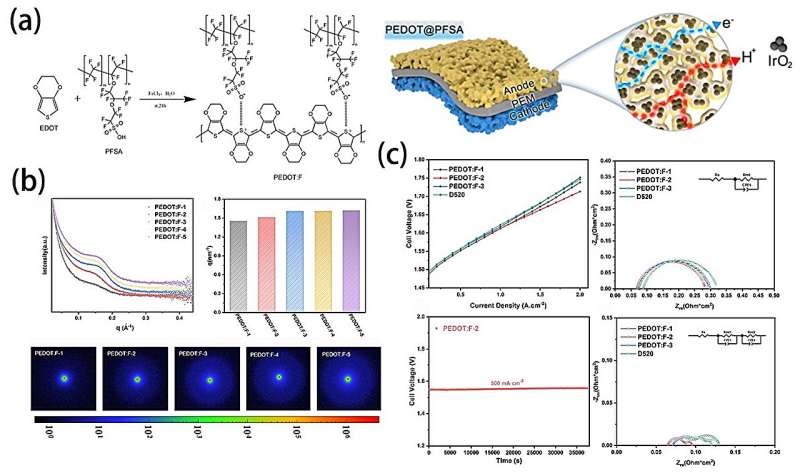This article has been reviewed according to Science X's editorial process and policies. Editors have highlighted the following attributes while ensuring the content's credibility:
fact-checked
proofread
Enhancing the performance of proton exchange membrane water electrolysis by constructing electron/proton pathways

The proton exchange membrane electrolysis of water (PEMWE) is a critical process for hydrogen generation. However, the limited ability of electrons and protons to permeate the membrane and the inefficient arrangement of the transport structure in the catalyst layer (CL) presents significant obstacles to the widespread adoption of PEMWE.
A group of researchers from China has developed a hybrid proton-electron conductor known as PEDOT:F ionomer, which has been incorporated into the CL as a catalytic binder. This development, as senior and co-corresponding author Haolin Tang explained, aimed to achieve a uniform anode CL structure and establish an effective three-phase interface by creating a proton/electron double conduction channel.
The researchers published their findings in Advanced Powder Materials.
PEDOT:F, in conjunction with perfluorinated sulfonic acid (PFSA), demonstrates a high degree of side chain extensibility, promoting the formation of hydrophilic ion clusters and facilitating the adsorption of water reactants onto the catalyst's surface.
Compared to the commercial nafion perfluorosulfonic acid (PFSA), the PEDOT:F ionomers exhibit superior oxygen evolution reaction (OER) performance as catalyst binders. According to Tang, both experimental data and Density Functional Theory (DFT) findings validate that the utilization of PEDOT enhances catalytic activity by increasing conductivity and reducing the energy barrier.
Furthermore, the enhanced electronic conductivity of PEDOT:F, combined with its larger hydrophilic ion clusters, eases the adsorption of reactant water on the catalyst's surface, promoting the electrochemical reaction. Moreover, the electrode containing PEDOT:F displayed outstanding ohmic resistance compared to that made with Nafion, with reductions of 23.4% and 17.6% at current densities of 0.1 A·cm-2 and 1.5 A·cm-2, respectively.
Tang noted that the improved performance can be attributed to the superior conductivity of both protons and electrons in PEDOT:F, along with its outstanding structural stability. This feature facilitates the smooth migration of particles during the electrolytic process, thereby enhancing the performance of PEMWE.
More information: Liyan Zhu et al, Enhancing proton exchange membrane water electrolysis by building electron/proton pathways, Advanced Powder Materials (2024). DOI: 10.1016/j.apmate.2024.100203
Provided by KeAi Communications Co.





















